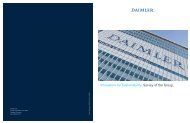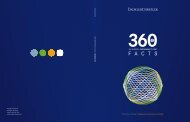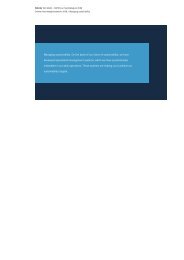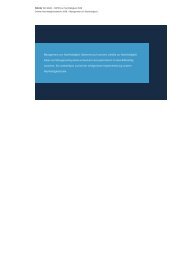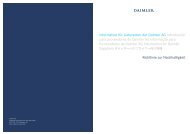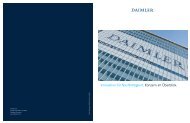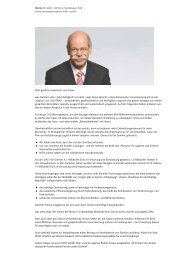Dear readers, This report describes what Daimler means by ...
Dear readers, This report describes what Daimler means by ...
Dear readers, This report describes what Daimler means by ...
You also want an ePaper? Increase the reach of your titles
YUMPU automatically turns print PDFs into web optimized ePapers that Google loves.
<strong>Daimler</strong> 360 GRAD - FAKTEN zur Nachhaltigkeit 2008<br />
<strong>Daimler</strong> Nachhaltigkeitsbericht 2008 / Managing sustainability / Environmental management system<br />
Environmental management system<br />
Protecting the environment is a primary objective of the <strong>Daimler</strong> Group. It is a fixed component of our corporate<br />
strategy with basic objectives defined in the Group’s environmental protection guidelines, which are passed <strong>by</strong><br />
the Board of Management and are binding for all of our employees and business locations (see box). A detailed<br />
version of the environmental guidelines is available as a PDF file in the Download Center.<br />
As an automaker we must keep environmental protection in mind throughout the entire lifecycle of our products<br />
- from deliveries <strong>by</strong> our suppliers to development, logistics, production, sales and utilization, as well as the<br />
disposal or recycling of end-of-life vehicles.<br />
The Group’s environmental protection guidelines<br />
� We face the environmental challenges of the future <strong>by</strong> working continuously to improve the environmental<br />
performance of our products and operations.<br />
� We strive to develop products which in their respective market segments are highly environmentally<br />
responsible.<br />
� We plan all stages of manufacturing to provide optimal environmental protection.<br />
� We endeavor to achieve exemplary environmental performance worldwide.<br />
� We provide our employees and the public with comprehensive information on environmental protection.<br />
Production-related environmental protection. The certification of all our locations around the world in line with<br />
ISO 14001 and additional validation of our German locations <strong>by</strong> the EU’s Eco-Management and Audit Scheme<br />
(EMAS) are important elements of our environmental management system. The efficacy of the system is regularly<br />
audited <strong>by</strong> external experts. Today, more than 96 percent of our worldwide workforce is employed in production<br />
facilities with certified environmental management systems.<br />
The merging of the management systems for quality, environmental protection, and occupational health and<br />
safety into a single system is an important goal at <strong>Daimler</strong>. As a result, environmental protection tasks are being<br />
integrated even more fully into the core functions and processes of the respective units, instead of being dealt<br />
with as separate processes. An integrated concept has already been implemented since 2002 in the production<br />
facilities of Mercedes-Benz Cars around the world.<br />
In addition, our process for evaluating the environmental risks connected with our production facilities<br />
throughout the world helps us to identify environmental risks on the basis of uniform standards, minimize them,<br />
and thus to refine our preventive measures for environmental protection. These audits involve regular and<br />
systematic monitoring and assessment of the location’s environmental management system as well as the key<br />
areas of environmental protection, such as atmospheric emissions, wastewater, waste disposal, and handling of<br />
hazardous materials. Elimination of any existing environmental risks is a component of the target agreements<br />
concluded between the Board of Management and plant managements.<br />
Environmental protection in product development. Vehicle development takes place in a standardized process in<br />
which the vehicle specifications and quality gates (milestones in the development process) form the<br />
cornerstones. Environmental protection issues and requirements (fuel consumption, emissions, prohibited or<br />
prescribed materials, and recycling requirements) are an integral part of the vehicle specifications and are taken<br />
into account and managed throughout the entire product creation process within the framework of the quality<br />
gates.



